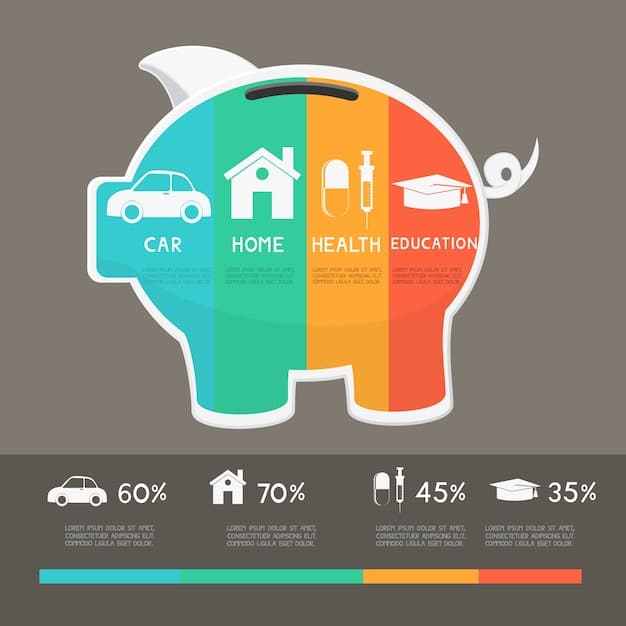Understanding the Statute of Limitations on Debt in Your State: A 2025 Guide

Understanding the Statute of Limitations on Debt in Your State: A 2025 Guide is crucial for protecting your financial rights by knowing the time limit creditors have to sue for debt repayment, which varies by state and debt type.
Navigating the world of debt can be overwhelming, especially when dealing with collectors and legal jargon. Understanding the Statute of Limitations on Debt in Your State: A 2025 Guide can provide much-needed clarity.
What is the Statute of Limitations on Debt?
The statute of limitations on debt is essentially the legal timeframe within which a creditor or debt collector can sue you to recover a debt. Once this period expires, the debt is considered “time-barred,” meaning the creditor loses the right to take legal action to collect it.
However, it’s important to note that the debt doesn’t magically disappear. You still technically owe the money, but the creditor’s legal recourse is limited. This doesn’t prevent them from continuing to contact you to request payment, but they can’t file a lawsuit.
How Statutes of Limitations Work
Statutes of limitations are designed to ensure fairness and prevent old, potentially unreliable, claims from being litigated. Memories fade, evidence can be lost, and witnesses may become unavailable over time. By setting a time limit, the law aims to promote timely resolution of disputes.
- Protects debtors from lawsuits on very old debts.
- Encourages creditors to take prompt action to recover debts.
- Reduces the risk of fraudulent or inaccurate claims.
Factors Affecting the Statute of Limitations
The length of the statute of limitations varies depending on the type of debt and the state where you live. Common types of debt include credit card debt, medical debt, auto loans, and personal loans. Each state has its own laws outlining the specific timeframes for each type of debt.
Generally, the statute of limitations ranges from three to ten years, but it’s crucial to check your state’s specific laws to determine the applicable period for your specific situation. Ignoring these timelines can have lasting impacts on your credit and financial well-being.

In conclusion, the statute of limitations on debt sets a crucial boundary for creditors, defining how long they have to pursue legal action. It’s vital to understand these statutes to protect yourself from old debt claims, although the exact timeframe can vary.
State-Specific Statute of Limitations in 2025
The most critical factor in understanding the statute of limitations is recognizing that it’s not uniform across the United States. Each state has its own laws that govern the timeframe for various types of debt.
It is crucial to know the specifics for your state. Misunderstanding these laws can lead to unnecessary stress and potential financial harm.
Common State Variations
While there are general trends, the statute of limitations can vary significantly from state to state. For example, some states might have a shorter period for credit card debt compared to medical debt, while others might treat all unsecured debt the same.
- California: 4 years for written contracts, 2 years for oral agreements.
- New York: 6 years for contracts.
- Texas: 4 years for most debts.
How to Find Your State’s Laws
Researching your state’s statute of limitations is essential. You can typically find this information through your state’s legislative website, the state bar association, or by consulting with an attorney. Websites like Nolo.com also provide state-by-state guides, but always verify the information with official sources.
It is always a good idea to review the most current laws, as updates and changes can occur. Staying up to date is the best way to protect your rights as a debtor.
In summary, understanding the specific statute of limitations in your state is crucial for properly managing your debt and avoiding potential lawsuits. Staying informed on state laws can provide valuable protection.
Types of Debt and Their Respective Statutes
Not all debt is created equal, and the statute of limitations often varies depending on the type of debt. The most common categories include credit card debt, medical debt, auto loan debt, and written contract debt.
Understanding the differences between these debt types can significantly impact how long a creditor has to pursue legal action against you.

Credit Card Debt
Credit card debt is generally considered unsecured debt, meaning it’s not tied to a specific asset like a car or a house. The statute of limitations for credit card debt is often based on the state where the cardholder resides or where the credit card agreement was signed.
Usually, the statute of limitations of credit card debt might range from three to six years, depending on the state’s laws. Be cautious, as making a payment or acknowledging the debt can restart the clock in some jurisdictions.
Medical Debt
Medical debt is another common form of unsecured debt. The statute of limitations for medical debt is subject to state laws, and can vary even within a single state depending on the healthcare provider or the type of service provided. Some states treat medical debt similarly to credit card debt, while others have specific statutes.
- Check if the debt has been sold to a collection agency.
- Understand your rights under the Fair Debt Collection Practices Act (FDCPA).
- Negotiate a payment plan or settlement if possible.
Auto Loan Debt
Auto loan debt is typically secured, meaning the lender has a lien on the vehicle. If you fail to make payments, the lender can repossess the car. The statute of limitations doesn’t usually apply in the same way as with unsecured debt because the lender has the option of repossession.
If the vehicle is repossessed and sold, and there’s still a balance owing (a deficiency), the statute of limitations might apply to that deficiency balance. This often depends on the state’s laws regarding secured transactions.
In conclusion, different types of debt are subject to different statutes of limitations, primarily dictated by whether the debt is secured or unsecured and state-specific regulations. Identifying your specific debt type is essential in understanding your rights.
What Happens When the Statute of Limitations Expires?
Once the statute of limitations on a debt expires, the creditor loses the legal right to sue you to recover the debt. The debt becomes “time-barred,” and you have a legal defense against any lawsuit filed by the creditor.
It’s crucial to understand the implications and how to protect yourself if a creditor attempts to sue you after the statute of limitations has passed.
Implications of a Time-Barred Debt
An expired statute of limitations doesn’t make the debt disappear entirely. You still owe the money, but the creditor can no longer use the court system to force you to pay. They can still contact you and request payment, but they can’t legally compel you through a lawsuit.
- The creditor cannot obtain a judgment against you.
- A judgment can lead to wage garnishment or property liens.
- You can raise the statute of limitations as a defense in court.
How to Handle Collectors for Time-Barred Debts
Even after the statute of limitations expires, debt collectors may continue to contact you in an attempt to collect the debt. It’s essential to know your rights and how to handle these situations effectively.
Document every communication with the debt collector. Keep records of dates, times, names, and the content of the conversations. If they continue to pursue you after being informed the debt is time-barred, consider consulting with an attorney.
In summary, the expiration of the statute of limitations protects you from legal action by creditors, though they may persist in pursuing the debt. Knowing your rights and documenting all communications will provide you added financial peace of mind.
Reviving a Time-Barred Debt: What to Avoid
Even if the statute of limitations on a debt has expired, it’s possible to “revive” the debt, which essentially restarts the clock. Certain actions on your part can inadvertently give the creditor a new legal basis to sue you.
It’s vital to be aware of these actions and avoid them to protect yourself from potential legal action.
Making a Payment
One of the most common ways to revive a time-barred debt is by making even a small payment. In many states, any payment towards the debt is considered an acknowledgement of the debt, which restarts the statute of limitations.
Avoid making any payments, even if you feel obligated or pressured by the debt collector. Any amount, no matter how small, can have significant legal consequences.
Acknowledging the Debt in Writing
Another way to revive a debt is by acknowledging it in writing. This could include sending a letter to the creditor acknowledging that you owe the debt, even if you state that you can’t afford to pay it.
- Avoid signing any documents without consulting an attorney.
- Be cautious about responding to emails or online forms.
- Keep copies of all communication with the creditor.
Verbal Acknowledgement
In some jurisdictions, even a verbal acknowledgement of the debt can be enough to revive it, although this is less common and often harder for the creditor to prove.
In conclusion, taking caution to avoid reviving a time-barred debt is crucial to maintaining your legal protections. Avoid making any payments, acknowledging the debt in writing, or even verbally acknowledging the debt.
How to Use the Statute of Limitations to Your Advantage
Understanding the statute of limitations can be a powerful tool in managing your debt and protecting your financial well-being. It allows you to make informed decisions about how to handle old debts and avoid potential legal pitfalls.
However, it is still worth consulting legal aid and/or speaking with a profession about your specific scenario. There is no substitute for specialized guidance.
Documenting and Tracking Debt Information
One of the best ways to use the statute of limitations to your advantage is by documenting and tracking all your debt information. This includes keeping records of the original debt date, the last payment date, and any communication with creditors or debt collectors.
Having these records will help you determine whether the statute of limitations has expired and provide evidence if a creditor attempts to sue you on a time-barred debt. Create a file (physical or digital) to store all relevant documents.
Seeking Legal Advice and Assistance
Navigating debt laws and the statute of limitations can be complex, so seeking legal advice and assistance from a qualified attorney is often beneficial. An attorney can review your specific situation, advise you on your rights and options, and represent you in court if necessary.
- Consult with a debt relief attorney.
- Explore options like debt settlement or bankruptcy.
- Ensure compliance with the Fair Debt Collection Practices Act (FDCPA).
Negotiating with Creditors
Even if a debt is close to the statute of limitations, you may want to consider negotiating with the creditor. Negotiating a settlement can allow you to pay off the debt for less than what you owe.
In conclusion, using the statute of limitations strategically can give you leverage in managing your debt and protecting your financial situation. You can proactively defend your financial future.
| Key Point | Brief Description |
|---|---|
| ⏰ Statute of Limitations | Legal time limit for creditors to sue for debt repayment. |
| 🗺️ State Variations | Statutes vary by state and type of debt (e.g., credit card, medical). |
| 🚫 Reviving Debt | Avoid payments or written acknowledgments, which can restart the clock. |
| 🛡️ Legal Advice | Consult an attorney for guidance on your rights and debt management. |
Frequently Asked Questions
▼
It refers to the time frame within which a creditor can legally sue you to recover a debt. Once this period expires, the debt is considered time-barred, limiting the creditor’s legal recourse.
▼
Each U.S. state has its own laws outlining the time limit for various types of debt. These timeframes can significantly vary, generally ranging from three to ten years, depending on the state and debt type.
▼
Making a payment on the debt, acknowledging the debt in writing, or in some states, even verbally acknowledging the debt can restart the statute of limitations clock.
▼
Document all communications, know your rights, and consider consulting with an attorney. While they can contact you, they cannot legally sue you for a time-barred debt.
▼
No, it often varies depending on the type of debt, such as credit card debt, medical debt, or auto loan debt. Each type can be subject to different statutes based on state laws.
Conclusion
Understanding the statute of limitations on debt is vital for protecting your financial health. By knowing the laws in your state and avoiding actions that could revive time-barred debts, you can better manage your financial obligations and safeguard against unwarranted legal actions.





